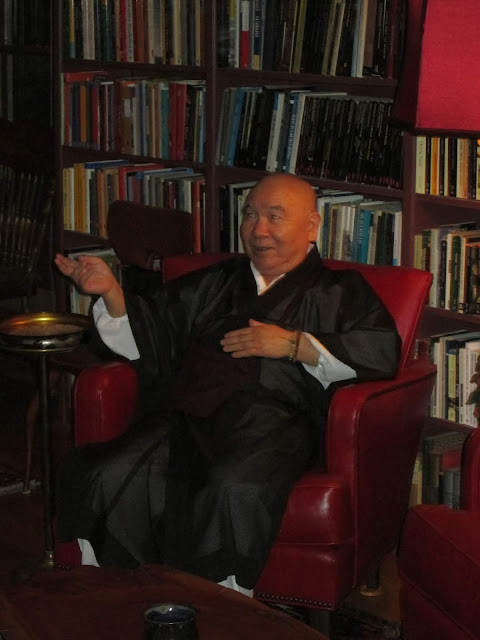Taking the next step in our exploration of Kobo Daishi Kukai's teachings on the meaning of the syllable Hum we will delve into the ultimate meanings of the syllable "A". Again we will use Yoshito S. Hakeda's translation that is included in his book, "Kukai: Major Works".
Kukai opens this section of his essay stating that the syllable A has three ultimate meanings. They are "being", "empty" and "uncreated" (Hakeda, p. 249).
The first ultimate meaning, being, is described in fairly straight forward terms. Regarding it, Kukai states:
"The letter A in the Sanskrit alphabet represents the first sound. If it is the first [in contrast to others], it is relative. we therefore define it as "[relative] being."
(Hakeda, p. 249)
Regarding the connotation of "empty" of the syllable A, Kukai explains:
"A also has the meaning of non-arising. If anything arises in dependence, it does not have its own independent nature. We therefore define it as "empty."
(Hakeda, p. 249)
Here are echos of Kukai's comments on the syllable H. He restates the lack of a true, original cause for phenomena, but that they arise from an infinitely complex and numerous web of causes. Also the term "non-arising" is similar to the use of the term "born" in the follow line in the Heart Sutra:
"O Sariputra, all things are characterized by emptiness; They are neither born nor do they perish..."
(Hakeda, p. 269)
So, this second ultimate meaning has a bit of a prajnaparamita flavor.
And in the third definition of the ultimate meaning of the syllable A, Kukai expands on the term "uncreated" It is important to remember that he introduced this term in the discussion of the syllable H in the following passage:
"...when we observe in various ways the causes and conditions of arising of all things, we see that all of them are of the uncreated."
(Hakeda, p. 248)
Kukai opens as follow:
"By "uncreated" is meant the Realm which is one and real, that is, the Middle Way [Absolute]. Nagarjuna said: "Phenomena are empty, temporal, and also middle."
(Hakeda, p. 249)
As with his treatment of the syllable H, here in the context of the syllable A we are met with a view that perceives and contains an order of reality that transcends the mundane.
Next Kukai begins to point to the distinct character of the syllable A:
"As the sound A is inherent in all other sounds, the mother of all sas it were, so what is truly and ultimately meant by the letter A pervades all things."
(Hakeda, p. 249)
Again, remember Kukai's final conclusion about the syllable H and its relevance to phenomena.
"...all things are of the World of Dharma; that is, the World of Dharma is the essence of all things..."
(Hakeda, p. 248)
He goes on, returning to the challenge of causation, the central connotation of the syllable H.
"...there is not a single phenomenon that is not the product of coordinating causes. What is produced by coordinating causes necessarily has its beginning and root. We see that these coordinating causes that affect the development of a phenomenon have in turn their manifold causes. Which should we regard as the root?"
(Hakeda, p. 249)
The above passage clearly reinforces the premise established in his analysis of the ultimate meanings of syllable H, that the nature of causality is so complex and multitudinous as to be beyond comprehension. Kukai, sums up this line of thought, reiterating that no original cause can be known.
"When we observe thus, we come to know that which is the limit, the "originally uncreated," which is the root of all phenomena."
(Hakeda, p. 249)
Next Kukai gives what, in my estimation is the most profound teaching in the entire essay.
"Just as we hear the sound A when we hear all sounds, so we perceive that which is the limit, the "originally uncreated," when we perceive the arising of all phenomena. He who perceives that which is the limit, the "originally uncreated," will come to know his mind as it really is. To know one's as it really is is [to gain] all-inclusive wisdom."
(Hakeda, p. 240)
Here Kukai clearly indicates that our simple perception of the world around us is no other than apprehending the nature of things. And, more importantly that perception is the path, the key to not only understanding our minds completely, but discovering our own buddhahood.
Wow, right?
I know our discussion of this is at best basic. But please forgive that and give this masterwork by the founder of Shingon a read. You won't be disappointed.
All quotes sourced from:
Kukai: Major Works, Yoshito S. Hakeda, Columbia University Press, 1972

















































